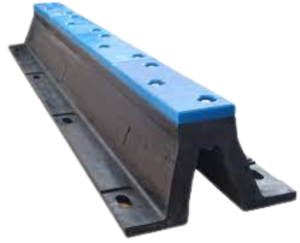Rubber Fender



- Rubber fenders are an essential component for marine vessels, as they provide protection against damage from collisions and impact.
- They are made of high-quality rubber compounds and are designed to absorb the energy of impact, reducing the amount of force transferred to the vessel. In this guide, we’ll explore the different types of rubber fenders and their applications, as well as their benefits and advantages.
Types of Rubber Fenders
- Cylindrical Fenders – These are the most commonly used fenders, and they come in a range of sizes to suit different vessels. They are cylindrical in shape and provide protection to the sides of the vessel.
- D Fenders – These fenders are shaped like a “D” and are designed to provide protection to the corners of the vessel.
- W Fenders – These fenders are shaped like a “W” and provide protection to the bow and stern of the vessel.
- Square Fenders – These fenders are square in shape and are commonly used for larger vessels. They provide protection to the sides of the vessel.
Benefits of Rubber Fenders
- Improved Safety – Rubber fenders reduce the risk of damage to the vessel and personnel during impact.
- Durability – Rubber fenders are made of high-quality materials and can withstand harsh marine environments, making them a long-lasting investment.
- Cost-Effective – Rubber fenders are a cost-effective solution for vessel protection compared to other alternatives.
- Easy Installation – Rubber fenders are easy to install and maintain, making them a popular choice for vessel owners.
Applications
Rubber fenders are used in a variety of marine applications, including :
- Commercial Shipping
- Fishing Vessels
- Cruise Ships
- Ports and Harbours
- Offshore Platforms
Conclusion
- Rubber fenders are an essential component for vessel protection, providing a cost-effective and durable solution for marine environments. With a range of types and applications, rubber fenders are a popular choice for vessel owners looking to improve safety and reduce the risk of damage during impact.
FAQs of different types of Rubber Fenders
Q: What are the different types of rubber fenders?
A: There are several types of rubber fenders, including :
- Arch Fenders: These are high-performance fenders that are designed to absorb large amounts of energy in a short time. They are commonly used in ports and harbors where larger vessels need to be protected.
- Cone Fenders: These are cylindrical in shape with a conical head. They are designed to absorb energy through a combination of compression and shear deformation. They are commonly used in smaller ports and harbors.
- Cell Fenders: These fenders have a cylindrical shape with multiple air-filled cells. They are designed to absorb energy through compression of the air in the cells.
- D Fenders: These fenders are shaped like a “D” and are commonly used on the sides of ships to prevent damage during berthing.
- Square Fenders: These fenders are square or rectangular in shape and are commonly used on docks and piers.
Q: What are rubber fenders?
A: Rubber fenders are types of devices used on ships, docks, and other maritime structures to absorb the energy of impacts and prevent damage to the vessel or structure. They are made of rubber or other elastomeric materials that can deform and absorb the impact force.
Q: What factors should I consider when choosing a rubber fender?
A: The factors to consider when choosing a rubber fender include the size and weight of the vessel, the speed of approach, the maximum allowable deflection, the type of dock or pier, the location of the fender, and the environmental conditions such as wave height and wind speed.
Q: How are rubber fenders installed?
A: Rubber fenders can be installed using various methods, including bolting, welding, and chains. The installation method depends on the type of fender, the location, and the structure.
Q: How often do rubber fenders need to be replaced?
A: The lifespan of rubber fenders depends on various factors such as the frequency of use, the severity of impacts, and the environmental conditions. Typically, rubber fenders have a lifespan of 10 to 15 years and need to be replaced when they show signs of damage or wear.

